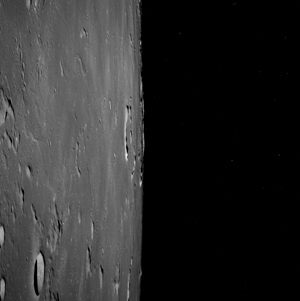
| Project Home | About the Scans | Browse Gallery | Image Map | Support Data | Resources | Ephemeris |
Featured Image - 12/23/2008
Celebrating the First Human Lunar Voyage:
Coming Soon to the Apollo Digital Image Archive
Forty years ago this week, on December 21, 1968, the Apollo 8 mission launched from the John F. Kennedy Space Center in Florida on an epic voyage of exploration and discovery. It is hard to overstate the significance of the Apollo 8 mission. For the first time, human beings left low-Earth orbit to directly explore another world, taking the first steps on a journey that will never end. Apollo 8 was the first crewed launch of the Saturn V launch vehicle, the first human mission to another planetary body, and the first time that a crewed spacecraft orbited another world. Apollo 8 succeeded because of the courage of Frank Borman, Jim Lovell, and Bill Anders, as well as the hard work of hundreds of thousands of dedicated people all across the United States. Apollo 8's memorable Christmas Eve television broadcast remains one of the most-watched television events in history (you can see this famous recording here). Apollo 8 met all of its mission objectives, paving the way for the subsequent Apollo landings and the future human exploration of the Solar System. For these reasons and many more, Apollo 8 is rightfully remembered today as a triumph of both the American space program and human ingenuity.
To celebrate the 40th anniversary of this extraordinary accomplishment, for this week's Apollo Featured Image, the Apollo Digital Image Archive is proud to present a special sneak preview of some of recent test scan products from the handheld cameras carried by the Apollo 8 astronauts. Over the past year, the Arizona State University School of Earth and Space Exploration and the NASA Johnson Space Center have been systematically scanning and releasing the images collected by the Apollo Metric Mapping Camera System carried aboard the command and service modules of Apollo missions 15, 16, and 17. As part of our project to digitally scan all of the original Apollo flight films, JSC and ASU have begun the process of scanning the original flight films for all of the 20,000+ still camera images taken by the Apollo astronauts with their handheld cameras in space and on the lunar surface.
The test images presented below were obtained by scanning the original first-generation Apollo 8 flight films using JSC's Oxberry-adapted HR500 scanner at 10 microns/pixel spatial resolution in 12-bit A/D mode. The raw scan images are very large. Accordingly, for these test images, we have converted them to 8-bit, reduced the file size, and corrected for the logarithmic nature of film in order to produce smaller "virtual prints," much like the Apollo metric camera virtual prints already available from this Archive.
One of the primary goals for the Apollo 8 astronauts while in lunar orbit was to survey and photograph some of the landing sites that were being considered at that time for the first human lunar landing. Figure 1 is an oblique view showing Mare Tranquillitatis, including Apollo Candidate Landing Site number 1. The observations of the Apollo 8 and Apollo 10 crews were an important part of the site selection process, and Apollo 11 was ultimately targeted at a different site (Apollo Candidate Landing Site 2, in southwestern Mare Tranquillitatis).
Figure1: Apollo 8 photograph AS08-13-2272, an oblique view of southeastern Mare Tranquilitatis including Apollo Candidate Landing Site number 1 [NASA/JSC/Arizona State University].
The Apollo 8 astronauts were also the first people to see the far side of the Moon with their own eyes. They obtained an extremely useful series of photographs of the lunar far side that nicely complemented existing Lunar Orbiter photography. Figure 2, below, is a spectacular close-up image of a region east of Korolev crater.

Figure 2: Apollo 8 Photograph AS08-13-2316, showing a region east of Korolev crater (the approximate image center point is 9 ° S, 153.5 ° W) [NASA/JSC/Arizona State University].
During Apollo 8, seven 70mm film magazines were exposed, yielding more than 150 photographs of the Earth and more than 700 photographs of the Moon. High-resolution scan products of these photographs, along with all of the rest of the Apollo camera images, will be made available from the Apollo Digital Image Archive during the next year using a new image browse interface that is currently being prepared. The original raw scan products and processed virtual prints in several sizes will be available from this new handheld camera section of the Apollo Digital Image Archive.
In 2009, the United States will take its first steps towards returning Americans to the Moon to stay by launching the Lunar Reconnaissance Orbiter. As we begin this daring new era of lunar exploration and development, the people working on the Apollo Digital Image Archive project are looking forward to sharing more of these spectacular records of the Apollo voyages with you in the months to come.
For more information:
NASA Celebrates Apollo 8
Lunar and Planetary Institute: Apollo 8 Photography Summary
Tweet
![]()

|
|
Space Exploration Resources |
|
 LPI LPI
|
